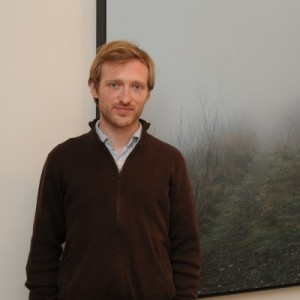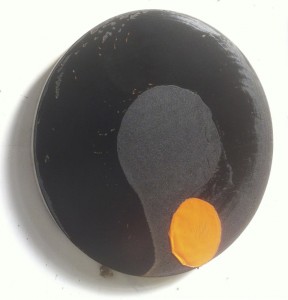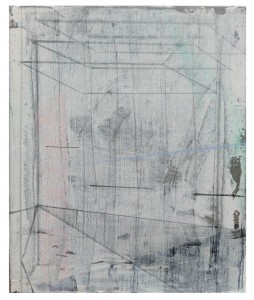
Wolfram Schnelle, co-director of Mummery + Schnelle Gallery. is in a prime location – a five minute walk away from Oxford Street station, which means they are either robbing a bank every other week, or they are successful enough to afford the inconceivable rent cost I’m sure they have. Its run by a director duo: Andrew Mummery and Wolfram Schnelle, I met Wolfram.
Tell us a little about yourself and the gallery.
We opened the gallery in September 2007. Andrew Mummery has had a gallery for ten years before we opened this one together and has developed the career of probably half the artists we represent now. I met Andrew when I was doing an internship with him. It’s a good match because he is from an art-history background and I am from a business background. Before coming here, I worked in marketing for a company that produces baby diapers. But I knew I wanted to work in Art, that’s where my passion was. So I came to London to do a Contemporary Art History course at Sotheby’s and then during that time me and Andrew started working together to start this gallery.
What are the benefits of being a co-director / what are the drawbacks of being a co-director?
To be honest I can only tell you advantages because in our case, having had a gallery, Andrew brings in contacts and very good artists. It would have been impossible to open a gallery and start from scratch at this time. When you have a co-director with you, there’s always a conversation with whatever happens, with discussions and confrontations which are always very constructive. I’m pleased I have a co-director and not running it on my own.
Why Contemporary Art? Why not antiques, modern art or Impressionists work?
I am very interested in the old masters, Velázquez is one of my favorite, but there’s something in contemporary art that really fascinates me and interests me in terms of working in the field. What drew me to it is working with the artists, working with somebody that is alive, that you can have a direct relationship with, someone you can see develop. I like the here-and-now of it that forces you to get thinking yourself. If I deal with old masters I would be dealing with the people that represent their work. These artists are part of the art historical canon already, while in contemporary art you don’t have that, therefore we are forced to make our own judgment, which is what fascinates me.
What is it that goes through your mind just before an exhibition opening?
Ohh! That’s interesting. It depends how you define it. Well the preparation starts six months before. Are you saying one hour before the opening?
Yes, let’s say one hour – after six months of planning, just before the people start coming in – what are you thinking?
When its all installed and all ready… Its a lot of wondering how the show will be received and hoping on practical things. You hope that the collectors you want to talk to don’t all arrive at the same time and you hope that you will have enough time to talk to all the people you are expecting. And you always want a good buzz at the opening, you don’t want just three people to be standing around.
Are you subconsciously thinking about the reputation of the gallery or potential sales?
You hope clients announce themselves, for sure. You want this to be a successful show financially for the gallery and for the artist. Ideally you want good reviews from art critics. Whenever we have an opening there’s always this slight anxiety and anticipation of what might happen and what might not happen. Its always rewarding when you have sales happening during an opening or before an opening.
Every year, art colleges and universities are pumping out hundreds of students who think that since they have a degree in Art they are now artists – ready to exhibit. These are usually between 21 and 25. I’m mentioning this because from looking at the list of artists from your website, the average age is 47. Is there any reason why you choose to represent work from older contemporary artists?
Yes and no. This is partly because Andrew had his gallery for ten years before this one and a lot of the artists we represent are around his age so when he started he was looking at his peers. Its all tied together because when we were looking for a new space, the career of the artists represented by Andrew had reached a certain point that it made more sense for them to be located in the West End rather then the East End. This is because they were, in a way, established. And when we add artists, we keep this in mind. Not necessarily that we only choose artists of the same field, but its something we have in the back of our heads. At the same time, I go to many degree shows and we have started working with artists coming directly out of Art schools. For example, the next show we will have a project by Mariana Mauricio who finished art school last year.
Do you have any comments regarding the high volume of students studying art which many of them want to become established artists.
I think it often takes time before an artist finds their own voice. Which is something necessary and needs time to develop. I think it can be very dangerous for an artist to be picked up too early.
What makes this dangerous?
I think the danger is that you start repeating yourself, and start doing what has been successful because of market pressure, which can push you in one direction instead of being free.
Wolfram Schnelle has to be one of the youngest gallery directors I have ever met. He genuinely seemed happy with his job.
Mummery + Schnelle, 83, Great Titchfield Street, London W1W 6RH www.mummeryschnelle.com
This interview was published on the February 2010 edition of MANIC Magazine, for The Malta Independent.







